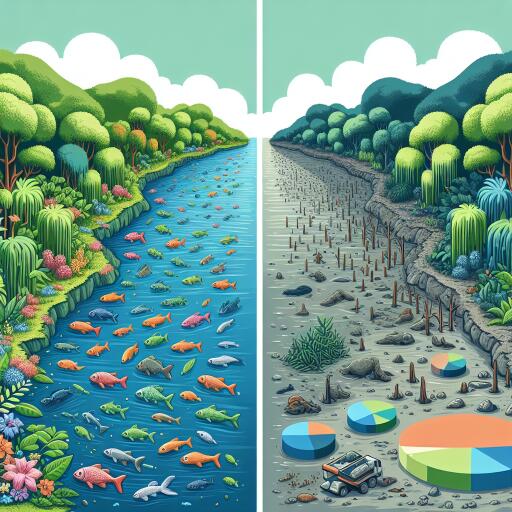
Successes and Failures of Conservation Actions to Halt Global River Biodiversity Loss – Nature Reviews Biodiversity
The intricate interplay of altered climate conditions due to human-induced greenhouse gas emissions has directly influenced the hydrology and temperature patterns of freshwater ecosystems. One of the stark impacts of rising temperatures is the reduction in water oxygen content, jeopardizing freshwater biodiversity.
Assessing conservation actions’ effectiveness, geographical reach, organismal coverage, and compatibility with regional drivers is crucial to refining ongoing and future efforts. Such evaluations, strengthened by case studies, reveal insights into different action categories’ outcomes and geographic trends.
Though each of the nine recognized conservation actions has the potential to bolster river biodiversity, overarching challenges curtail their full potential.
Habitat Degradation and Fragmentation
The transformation and fragmentation of habitats due to land-use changes are identified as leading causes of freshwater biodiversity decline. In river systems, these transformations impact entire catchments, yet conservation efforts often tackle this issue on a local scale. Enhancements, such as modifying river channels or bolstering habitat structure, are common measures. Addressing habitat fragmentation caused by dams includes improving connectivity through barrier removal or installing fishways.
Despite numerous projects focusing on habitat improvements, they often focus on macroinvertebrates or fish, sidelining other organisms. The diversity gain is inconsistent, often resulting in negative or negligible changes in some contexts. Biodiversity recovery can be complicated by external factors like pollutants or distant source populations for recolonization.
Environmental Flows
Environmental flows are critical for various purposes, including maintaining water availability, enhancing connectivity, and improving sediment transport. Conservation efforts focus on managing water abstraction to mimic natural flow regimes. Despite growing recognition of their importance, such actions cover only a fraction of altered rivers. Studies mainly target fish and macroinvertebrates, generally showing favorable outcomes; however, mismatches in flow requirements can hinder benefits, underscoring the necessity for adaptive management.
Pollution Management
Managing point source pollutants typically involves pollutant concentration reduction through treatment processes like wastewater treatment plants (WWTPs). Prompt action for pollution events can lead to swift biodiversity recovery. Yet, ongoing pollution from industrial waste remains a challenge unless its sources are managed effectively.
WWTPs are widely employed to curb pollutants like nitrogen and phosphorus. Though generally effective, deficiencies in understanding their impact on wider river biodiversity exist. Furthermore, microplastics and emerging pollutants often remain untreated, posing significant ecological threats.
Combatting Diffuse Pollution
Diffuse pollution, stemming from widespread pollutant sources, poses complex challenges. Conservation actions focus on reducing emissions, utilizing buffer strips, and adjusting chemical use. Legislative efforts have successfully decreased airborne pollutants, yet explicitly measuring impacts on river biodiversity is complex. Mitigating runoff pollution demands broader empirical studies and strategy refinement to enhance biodiversity outcomes.
Species and Substrate Exploitation
Riverbed mining and overfishing are forces of exploitation, impacting biodiversity. Efforts to counteract overfishing, via closures and quotas, often yield mixed results due to other unaddressed stressors or regulatory inconsistencies across jurisdictions. Successful interventions tend to involve holistic approaches, integrating habitat restoration and stakeholder collaboration.
Invasive Species Management
Conservation against invasive species involves prevention and control strategies. Prevention focuses on vector management and rapid response systems. Control can be highly effective, albeit more costly and logistically demanding. Effectiveness varies with taxa, often more successful with higher-trophic invaders.
Adaptation to Climate Change
Proposed measures to tackle climate change in river ecosystems aim to improve adaptability and address precipitation changes. Activities include enhancing shading through riparian planting, optimizing flow management, and fostering cold-water refuges. Despite the evident need, actions specifically targeting biodiversity remain scarce.
Protected Areas and Specialized Actions
Ideally, river habitat protection involves managing designated activities or implementing protected zones. However, this often falls short in practice, mostly targeting terrestrial systems. Effective river protection demands integrating terrestrial and aquatic strategies and promoting cooperative efforts with local communities.
Species-specific actions, ranging from creating Red Lists to habitat protection, are employed globally. However, significant gaps exist in assessing specific impacts, particularly for underrepresented groups.
Conclusion
The review of 436 studies highlights a sobering reality: conservation actions generally report minimal success in enhancing river biodiversity. While strategies vary globally, synchronization between stressor intensity and conservation efforts is paramount. Richer regions often engage in multifaceted projects, whereas resource-limited regions concentrate on simpler measures. This imbalance underscores the need for tailored, comprehensive, and inclusive conservation tactics worldwide.





Leave a Reply